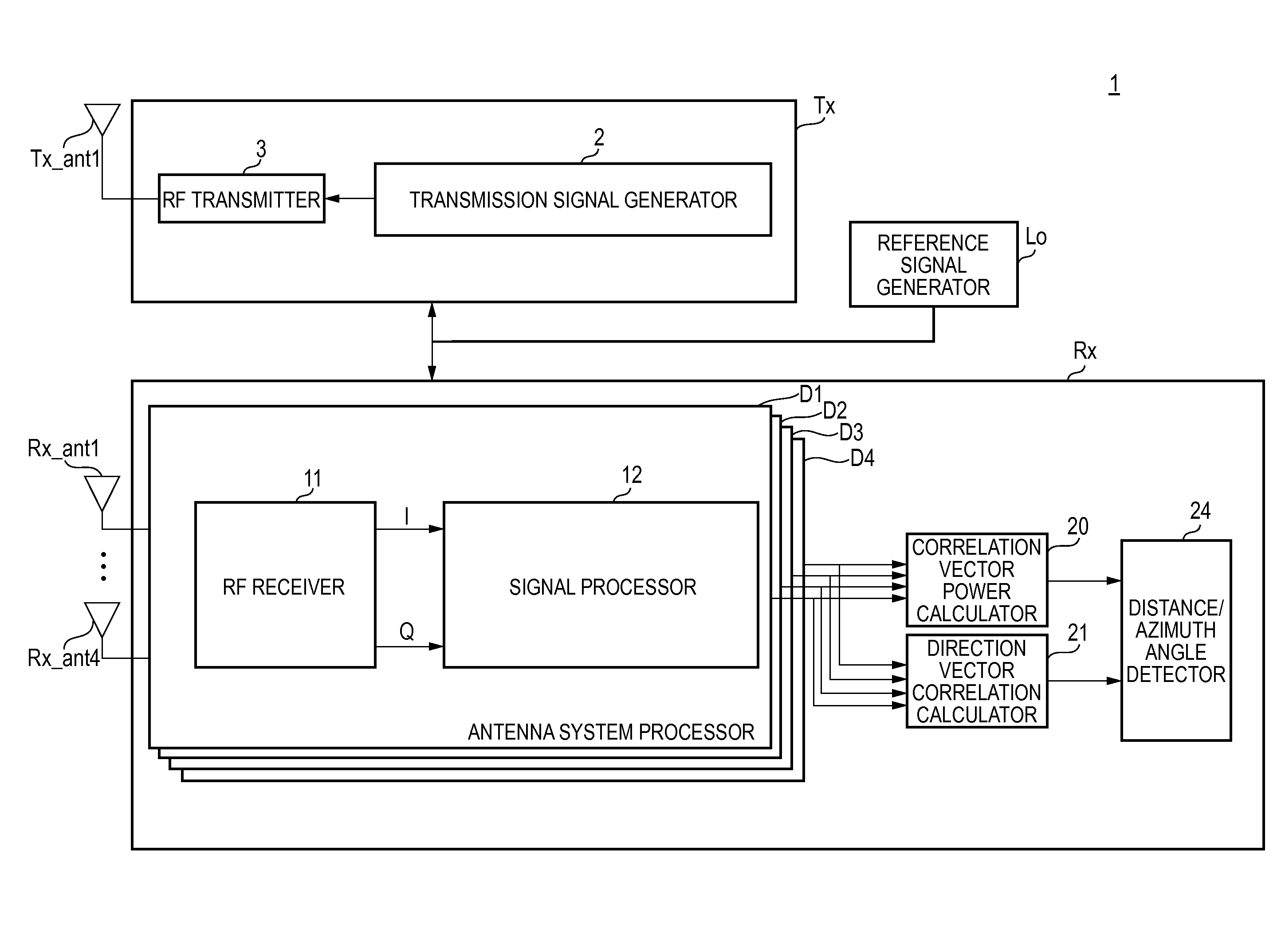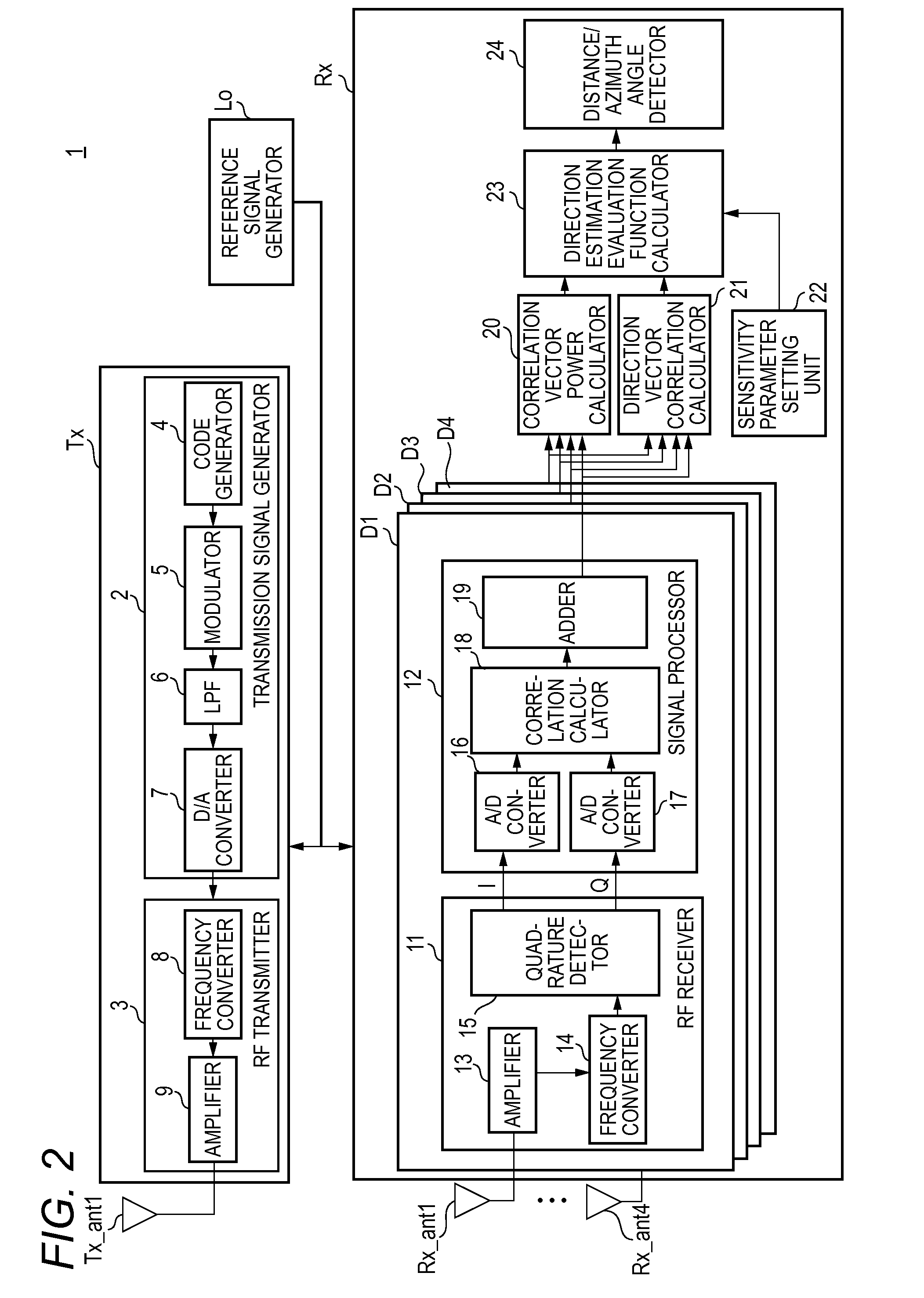Radar apparatus
a radar and apparatus technology, applied in the direction of reradiation, measurement devices, instruments, etc., can solve the problems of reducing the azimuth angle detection performance of the target and increasing the calculation amount of the radar apparatus, so as to suppress the increase of the calculation amount and reduce the sidelobe
- Summary
- Abstract
- Description
- Claims
- Application Information
AI Technical Summary
Benefits of technology
Problems solved by technology
Method used
Image
Examples
embodiment 1
[0039]How a radar apparatus 1 according to a first embodiment is configured and operates will be described with reference to FIGS. 1 to 6. FIG. 1 is a block diagram showing the internal configuration of the radar apparatus 1 according to the first embodiment in a simplified manner. FIG. 2 is a block diagram showing the internal configuration of the radar apparatus 1 according to the first embodiment in detail. FIG. 3 illustrates a relationship between transmission intervals and transmission cycles of a radar transmission signal.
[0040]The radar apparatus 1 transmits (radiates) a radio-frequency radar transmission signal generated by a radar transmitter Tx from a transmission antenna Tx_ant1. The radar apparatus 1 receives, with an array antenna (e.g., four reception antennas Rx_ant1 to Rx_ant4 shown in FIG. 1), a reflection wave signal which is a radar transmission signal as reflected by a target (not shown). The radar apparatus 1 performs signal processing on reflection wave signals...
embodiment 2
[0129]Next, a radar apparatus 1A according to a second embodiment will be described with reference to FIG. 9. FIG. 9 is a block diagram showing the internal configuration of the radar apparatus 1A according to the second embodiment in detail. The radar apparatus 1A includes a reference signal generator Lo, a radar transmitter Tx, and a radar receiver RxA.
[0130]The radar receiver Rx has four antenna system processors D1, D2, D3, and D4 (four is an example number), an orthogonal beam multiplier 25, a beam selector 26, a correlation vector power calculator 20A, a direction vector correlation calculator 21A, a sensitivity parameter setting unit 22, a direction estimation evaluation function calculator 23A, and a distance / azimuth angle detector 24.
[0131]Elements (and their operations) of the radar apparatus 1A according to this embodiment having the same ones in the radar apparatus 1 according to the first embodiment will be given the same reference symbols as the latter and descriptions...
embodiment 3
[0145]Next, a radar apparatus 1B according to a third embodiment will be described with reference to FIG. 10. FIG. 10 is a block diagram showing the internal configuration of the radar apparatus 1B according to the third embodiment in detail. The radar apparatus 1B includes a reference signal generator Lo, a transmission beam controller Be, a radar transmitter TxB, and a radar receiver RxB.
[0146]The radar transmitter TxB has a transmission signal generator 2, a transmission beam former 27, and a total of N_Tx RF transmitters 31, 32, . . . , 3N_Tx. Transmission antennas Tx_ant1, Tx_ant2, . . . , Tx_antN_Tx are connected to the respective RF transmitters 31, 32, . . . , 3N_Tx.
[0147]The radar receiver RxB has four antenna system processors D1, D2, D3, and D4 (four is an example number), a correlation vector power calculator 20, a direction vector correlation calculator 21B, a sensitivity parameter setting unit 22, a direction estimation evaluation function calculator 23B, and a distanc...
PUM
 Login to View More
Login to View More Abstract
Description
Claims
Application Information
 Login to View More
Login to View More - R&D
- Intellectual Property
- Life Sciences
- Materials
- Tech Scout
- Unparalleled Data Quality
- Higher Quality Content
- 60% Fewer Hallucinations
Browse by: Latest US Patents, China's latest patents, Technical Efficacy Thesaurus, Application Domain, Technology Topic, Popular Technical Reports.
© 2025 PatSnap. All rights reserved.Legal|Privacy policy|Modern Slavery Act Transparency Statement|Sitemap|About US| Contact US: help@patsnap.com



